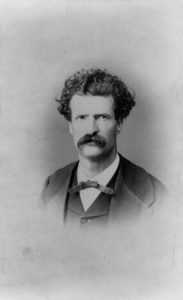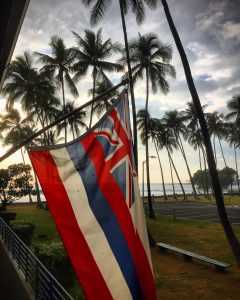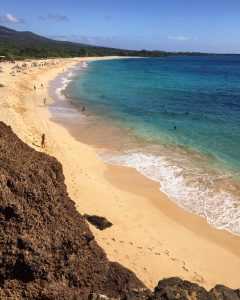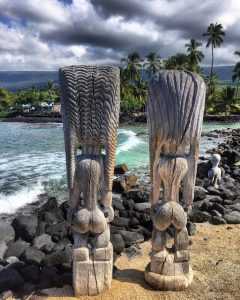WANDERLUST

In 1866, Mark Twain was virtually unknown without a single published book. He had bright red hair and he talked and gestured in such an animated way that people meeting him for the first time often thought he was drunk. And then he got one of the greatest jobs in history.
The Sacramento Union, the best newspaper on the West Coast, sent him to the Sandwich Islands (as Hawaii was then called) and agreed to pay $20 for every letter or story he sent back. Though Samuel Clemens, writing as Mark Twain, would go on to become the United States’ most famous writer and the author of “Tom Sawyer” and “Huckleberry Finn,” and would travel extensively around the world, he never forget Hawaii. He called it “the loveliest stream of islands that lies anchored in any ocean.”
Though he was only in Hawaii for four months in 1866 and never returned, much later in his life he wrote, “No alien land in all the world has any deep strong charm for me but that one, no other land could so longingly and so beseechingly haunt me, sleeping and waking, through half a lifetime, as that one has done … For me, its balmy airs are always blowing, its summer seas flashing in the sun; the pulsing of its surfbeat is in my ear; I can see its garlanded crags, its leaping cascades, its plumy palms drowsing by the shore, its remote summits floating like islands above the cloud wrack … in my nostrils still lives the breath of flowers that perished twenty years ago.”
So when my brother and I decided to spend two weeks exploring the Hawaiian Islands, who better to be our guide than Mark Twain? Armed with editions of Twain’s two travel books on the subject “Letters from Hawaii” and “Roughing It,” we decided to follow his route and see how much we could return to the Sandwich Islands of 1866, when it was still an independent kingdom and the most isolated population center on Earth.
Honolulu
Twain arrived in Honolulu on March 18, 1866, after a 10-day voyage and set out to explore the settlement of then 15,000. “The further I traveled through the town the better I liked it. Every step revealed a new contrast — disclosed something I was unaccustomed to … I saw luxurious banks and thickets of flowers fresh as a meadow after a rain, and glowing with the richest dyes … I saw huge-bodied, wide-spreading forest trees, with strange names and stranger appearance – trees that cast a shadow like a thundercloud … I saw long-haired, saddle-colored Sandwich Island maidens … gazing indolently at whatever or whoever happened along.”

Much like Mark Twain, we arrived in Honolulu after what seemed like a 10-day trip, although it was really just a seven-hour flight and five-hour delay. After negotiating the maze of Waikiki streets, we checked in, had a drink and walked out at midnight into a light mist of rain. And into a Hawaii not too far different from Twain’s. Oh, of course, Honolulu is a now sprawling city of 400,000, with eight million more tourists thrown in. But the shock of arriving from the mainland in winter was the same. Here there were flowers — everywhere — in January, with palm trees swaying overhead and huge banyan trees covering a city block. The temperature, even at midnight, was balmy and on every corner there were woman looking at us, perhaps not “indolently,” but at least sizing us up to see if we were potential customers. Waikiki is known for boasting a large collection of streetwalkers. They were all colors, races and sizes, and beautifully dressed. And strangely, they were working the territory in front of the Moana Surfrider, perhaps the most gorgeous and expensive of Waikiki hotels, and one of the oldest, dating back to 1901. On this street, Kalakaua Ave, which has the same look and feel of Rodeo Drive, with many of the same stores, it is an odd sight to see prostitutes on every corner.

The Waikiki of Twain’s day was a village of white cottages. It was the royal coconut grove and one-time home of King Kamehameha I, the king that united all of Hawaii by winning a famous battle here in 1795. It was also here on the thin sliver of Waikiki Beach that Mark Twain tried surfing, and first introduced the sport to the world. “In one place we came upon a large company of naked natives, of both sexes and all ages, amusing themselves with the national pastime of surf-bathing. Each … would paddle three or four hundred yards out to sea (taking a short board with him), then face the shore and wait for a particularly prodigious billow to come along; at the right moment he would fling his board upon its foamy crest and himself upon the board, and here he would come whizzing by like a bombshell! It did not seem that a lightning express-train could shoot along at a more hair-lifting speed. I tried surf-bathing once, subsequently, but made a failure of it. I got the board placed right, and at the right moment, too; but missed the connection myself. The board struck the shore in three-quarters of a second, without any cargo, and I struck the bottom about the same time, with a couple of barrels of water in me.”

Today, of course, they are still surfing at Waikiki and the beach is home to the ultimate surfing tribute, a statue of the king of the board, Duke Kahanamoku. But the real excitement of surfing in winter is on the north shore of the island — a place that would have been inaccessible to Mark Twain except by boat, because in 1866, no road penetrated Oahu’s central spine of mountains.
Today, it’s a drive of an hour or so by tunnels and highway to Sunset and Banzai-Pipeline Beaches. Both are known for their flat reefs that cause waves to break when they hit shallow depths, creating a huge curling tube of water that surfers can actually ride down the center. In winter, these can be the deadliest of beaches with waves averaging nine feet, and reaching even 14-20 feet high, with the constant danger of surfers being hurled into the coral below.
The incredible thing when visiting is that the main road is literally at the edge of the beach. You just pull over for free parking, and in less than a minute you can walk right up to the gigantic breaking waves and be so close that you can actually photograph a surfer in curl … with a cell phone! Of course, the beach is lined with professional photographers with two-foot long telephotos and some of the top surfing photos come from here, but you don’t need one to feel part of the action. You can buy cold coconuts at the beach, or it’s a short drive to Hale’iwa, an old hippie surfing town that is also home to the most famous of all North Shore stops: Matsumoto’s Shave Ice.

Diamond Head
This 700-foot-high extinct crater looms over Honolulu and has fascinated every visitor from Mark Twain to the TV show “Hawaii Five-O.” Twain rented a broken-down horse named Oahu and struggled to the top, but now people think nothing of walking from Waikiki and climbing to the summit at dawn, taking a $10 cab ride back to their hotel. It’s an interesting hike, with tunnels and curving staircases cut through rock. The summit was converted to an army lookout point in World War II. Of course, the view today includes hundreds upon hundreds of modern hotels, apartments and office buildings, but nothing much has changed along the shoreline or in the steep mountain crags, so much of the view is the same as Mark Twain described it: “Impressed by the profound silence and repose that rested over the beautiful landscape … I gave voice to my thought. I said: What a picture is here slumbering … How strong the rugged outlines of the dead volcano stand out against the clear sky! What a snowy fringe marks the bursting of the surf over the long, curved reef! How calmly the dim city sleeps yonder in the plain! How soft the shadows lie upon the stately mountains that border the dream-haunted Manoa Valley! How … at this point the horse called Oahu deliberately sat down in the sand. Sat down to listen, I suppose … I stopped apostrophizing and convinced him that I was not a man to allow contempt of court on the part of a horse.”

On his way back to town, Twain noticed a beautiful island woman and thinking to impress her, he galloped by like a cavalier. She called to his friend Brown, who was bringing up the rear and spoke to him. Twain waited and when Brown caught up, he asked what she had said. Brown laughed. “She thought from the slouchy way you rode and the way you drawled out your words, that you was drunk! She said, ‘Why don’t you take the poor creature home, Mr. Brown? It makes me nervous to see him galloping that horse and hanging on that way, and he so drunk.’”
Maui
Twain’s next stop was Maui. He wrote famously, “I went to Maui to stay a week and remained five. I had a jolly time. I would not have fooled away any of it writing letters under any consideration whatever … I never spent so pleasant a month before, or bade any place good-bye so regretfully.”
Most people feel the same way. Twain based in Lahaina, so we did too. In the 1800s, this large whaling town could have 400 ships in harbor at a time, and seemingly just as many bars, saloons and brothels. One of the surviving buildings from the era is the sturdily built town jail. Today, Front Street, Lahaina is a wacky mix of tourist shops, historic buildings with balconies, restaurants, galleries, stone churches and bars, with an old fort and picturesque harbor that offers bobbing boats and classic mountain and sea views.

Perhaps the two most familiar landmarks — the giant banyan tree that covers an entire city block and the historic balconied Pioneer Hotel where writer Jack London once stayed, both came after Twain’s visit, But there are a dozen or so buildings from his time, and no matter how many Subway sandwich shops and pizza joints invade, Lahaina still has the look of an old whaling town. Have a local Haleakala IPA from the Maui Brewing Company on the balcony of Captain Jack’s Island Grill, and you can drift with the swaying overhead palm trees back to a different time.
By 1866, the missionaries had arrived in Lahaina, and were in steady conflict with the sailors, the native Hawaiians and Mark Twain, who loved needling them. He complained that the missionaries had come to make the native people “permanently miserable by telling them how beautiful and how blissful a place heaven is, and how nearly impossible it is to get there.” He wrote: “How sad it is to think of the multitudes who have gone to their graves in this beautiful island and never knew there was a hell.”
One of Mark Twain’s permanent gifts to Maui was popularizing the idea of watching sunrise from the 10,023-foot summit of the extinct volcano Haleakala, “the house of the sun.” Twain camped on the top and at dawn had the not uncommon experience of being in bright sunshine, while all below him was blanketed with clouds. “It was the sublimest spectacle I ever witnessed, and I think the memory of it will remain with me always,” he wrote. Today, the ritual, which involves driving twisting roads in the dark and freezing on the summit until the sun comes up, has become so popular that as of Feb. 1, 2017, the National Park Service requires permits and only cars with permits are allowed on the summit at dawn. No matter. The summit view is fantastic at any time, and since the volcano is covered with hundreds of microclimates, there are always constantly swirling clouds and light formations. Dress warm.

The Big Island of Hawaii
With its active volcano, waterfalls, and historic sites, Twain liked the island of Hawaii above all else. He sailed from Honolulu and wrote, “We landed at Kailua (pronounced Ki-loo-ah), a little collection of native grass houses reposing under tall coconut trees — the sleepiest, quietest, Sundayest looking place you can imagine. Ye weary ones that are sick of the labor and care … and sigh for a land where ye may fold your tired hands and slumber your lives peacefully away, pack up your carpet sacks and go to Kailua! A week there ought to cure the saddest of you.”
I liked Kailua best of all myself. The historic town consists of a half moon bay with the sea on one side, where towering waves crash against a rock wall breakwater every minute or so, sending a spray water splashing over the sidewalk. On the other side, is a South Pacific paradise of historic buildings sprinkled with new ones made to look old with shutters, balconies, bars, live music, ABC liquor stores, towering palm trees and an assortment of Hawaiian tourists shops.

Of course, it’s touristy. There’s a steady stream of cars, convertibles, motorcycles and people, with drifts of a live singer doing John Denver or a tourism shop playing Iz Kamakawiwo’ole’s “Somewhere Over the Rainbow,” a song, by the way, that you’ll probably hear more than a hundred times. The official Youtube page for the song has 261 million views. I suppose there are people who hate it, but to me, never has a song captured a place better. Even Mark Twain, 100 years before the song was recorded, wrote, “Why did not Captain Cook have taste enough to call his great discovery the Rainbow Islands? These charming spectacles are present to you at every turn; they are as common in all the islands as fogs and wind in San Francisco.”
Captain Cook was killed in Hawaii, a fact that fascinated Twain, and he spent a great deal of time visiting the site of the murder, and also the site where Cook was “cooked.” Twain had no great respect for Captain Cook, who he thought had pretended to be a god and got what he deserved. He delighted in the fact that when the British demanded the return of Captain Cook’s body, the natives could sheepishly only produce nine pounds of it … the rest having been eaten. The monument to Cook that Twain visited is now underwater. Not a good sign for global warming.

The big island is filled with sights visited by Twain that have changed little if at all. You can walk by the massive black lava walls of Pu’uhonua o Hōnaunau, the City of Refuge, which is now a National Park. The earth’s largest volcano, Mauna Loa, is still 13,677 feet high and consumes half the island, while the planet’s youngest and most active volcano, Kilauea, is still spewing gas, smoke and ash, as it did when Twain climbed down into it. You can have the same view of Halema’uma’u Crater from the Volcano House, that he enjoyed. The current restaurant is new, but the location of the park’s only hotel is the same. He wrote, “The surprise of finding a good hotel in such an outlandish spot startled me considerably more than the volcano did.” Not only is the drop off the Kīlauea caldera steep, but so are the restaurant prices. But at least stop in Uncle George’s Lounge for a Kona Brewing Co. IPA and the splendid view. You might even want to stand by the fireplace — at 4,000 feet, it can be chilly up here.
Mark Twain also rode through the Waipi’o Valley, which is just as inaccessible today as in 1866, and rode up and down all of the Kona Coast, writing, “Kona to me will always be a happy memory.”
THE NEWS










